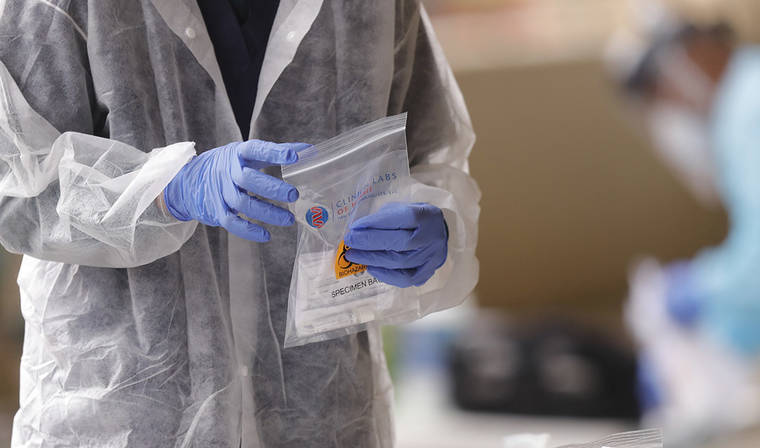Editorial: Progress and beating the coronavirus will take array of tests and contact tracing

JAMM AQUINO / JAQUINO@STARADVERTISER.COM
A testing specimen is secured during a drive-thru COVID-19 testing put on by Kalihi Kai Urgent Care on Saturday at Ala Moana Center.
There is a road map leading out of the shutdown box in which island residents now live. It’s one that surely will be adjusted and redrawn as events continue to unfold, and as more businesses are taking their first steps.
Although Hawaii and the U.S. generally lost critical first weeks of information that a much wider testing program might have yielded, the reopening of business and social activities that has just begun still will be data-driven.
A crucial piece, still in development, is contact tracing: Those exposed to the virus from someone with a confirmed infection are located and isolated.
The state’s current force of contact tracers — people who interview those testing positive for COVID-19 Opens in a new tab to find others whom they might have exposed — can handle the task now at hand. That’s thanks in large part to the fact that a crackdown on tourism and business activity generally has “flattened the curve” of new disease cases.
It’s also due to the broad compliance with the stay-at-home order and social distancing which, in conjunction with good hygiene and hand-washing, remain the only real tools for combatting the coronavirus. This does not diminish the power of those tools: Hawaii’s counts of new individual cases have been in single digits for weeks.
That Hawaii is in an enviable place, however, does not negate the fact that this is a precarious juncture. The state must pursue ways to expand its network of surveillance, its contact tracing and its protections for the front-line health-care workers who are coping with the disease.
Don't miss out on what's happening!
Stay in touch with breaking news, as it happens, conveniently in your email inbox. It's FREE!
Any lapse into a pre-pandemic mode of behavior, ignoring those effective precautions, will put the state in danger.
Instead, work must accelerate, on multiple fronts. One of them is contact tracing. Encouragingly, the state Department of Health last week announced its plan to use a new digital tool, developed by HealthSpace (www.gethealthspace.com/contact-tracing Opens in a new tab) to help with this task.
The app, equipped with privacy protections, will allow those who test positive to submit their contacts themselves.
Not everyone will be able or willing to use the app, though, which means there will be more than enough work for the roughly 80 DOH staff and volunteers tasked with the person-to-person questioning.
Bruce Anderson, director of the state Department of Health, said in an interview Thursday that the state will clearly need to expand that force to be ready for any increase in infections.
Although the state remains officially on a stay-at-home order through May, a phased reopening of businesses has begun, thankfully, starting with those requiring the least intensive social interactions.
Even with scrupulous care, though, the extremely contagious coronavirus is sure to get out.
Anderson said his department will use positions that are already budgeted for a more immediate expansion of contact tracing, but pointed out, with good reason, that the Legislature will need to consider funding increased staffing for this purpose, for the foreseeable future.
Even beyond the extensive period of battling this virus, Hawaii needs better response capacity for flu and other outbreaks that are anticipated — but especially for those that are unexpected.
In a news conference on Wednesday, Anderson said that DOH is drafting a comprehensive plan to provide a focal point for testing. This will include an expansion of its established sentinel testing network of 32 physicians statewide who detect infectious diseases in the community. The network should soon include community health centers and other health-care providers.
This is good news, because the state needs to continually refine its testing strategy as new technologies are evaluated and shown to be reliable. Anderson said Hawaii is testing 1,000 daily and has capacity for 3,000 daily tests. That gives us some breathing room at this point but surely won’t be enough downstream.
There were advances last week here. Among them: DOH distributed a total of 12 devices to all counties for running the samples in Abbott ID NOW rapid test instruments, and staff have been trained on them.
In addition, the advent of antibody tests, announced last week by Clinical Labs of Hawaii, should bring clarity to the extent of the community spread across the state.
But Anderson rightly cautioned against relying on them for admitting employees to work or visitors into the state. Antibodies show exposure to the disease but neither immunity nor clearance from being currently infectious. One Maui woman, who had earlier recovered from COVID-19, was found on Wednesday to be reinfected.
This is a dread disease, and little understood. Hawaii’s health-care system and its overseers will have to be adept to stay on top of better data and innovative approaches.
That’s why the progress forward will be necessarily slow and halting, with an eye on the prize: a Hawaii that recovering, with as much protection as we all can muster.




